Bachelor of Nursing: Focused Assessment Report on COPD Patient Care
VerifiedAdded on 2022/10/02
|8
|2431
|358
Report
AI Summary
This report provides a comprehensive nursing assessment of a 78-year-old female patient, Mary Montgomery, suffering from severe COPD. It begins with an introduction to the patient's condition, including her symptoms and medical history. The report then explains the difference between subjective and objective data, providing examples from the case study. The assessment data is categorized into subjective and objective findings, highlighting key observations such as respiratory rate, oxygen saturation, and physical limitations. The report identifies the focused assessments performed by the virtual nurse, including respiratory, fall risk, nutritional status, and pressure risk assessments. Furthermore, it proposes four additional nursing focused assessments, namely mental status, and discusses the rationale for these assessments based on supporting academic literature. The report emphasizes the importance of comprehensive assessment in planning effective nursing care for patients with COPD, considering the multifaceted nature of the disease and the need for individualized interventions.
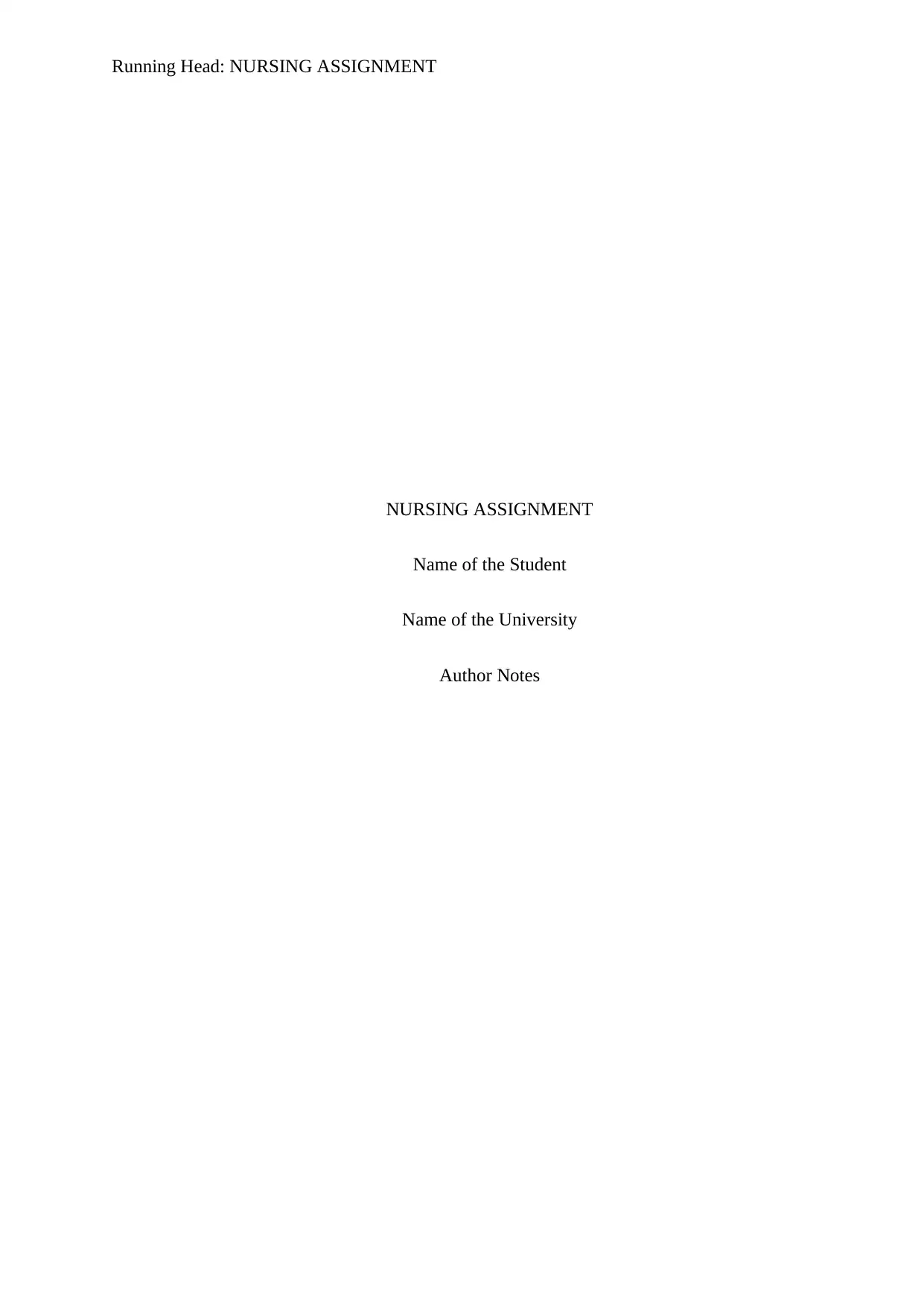
Running Head: NURSING ASSIGNMENT
NURSING ASSIGNMENT
Name of the Student
Name of the University
Author Notes
NURSING ASSIGNMENT
Name of the Student
Name of the University
Author Notes
Paraphrase This Document
Need a fresh take? Get an instant paraphrase of this document with our AI Paraphraser
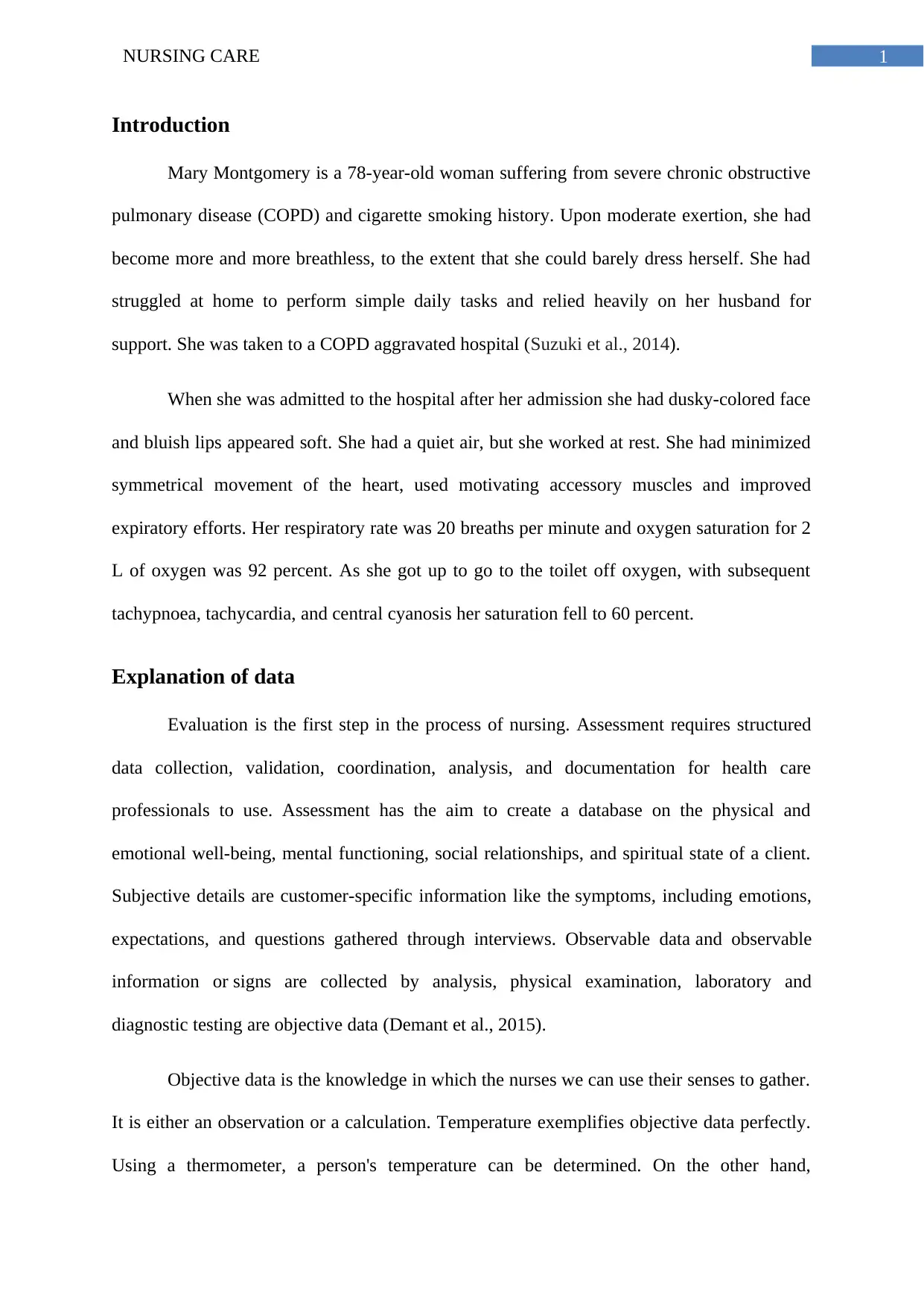
1NURSING CARE
Introduction
Mary Montgomery is a 78-year-old woman suffering from severe chronic obstructive
pulmonary disease (COPD) and cigarette smoking history. Upon moderate exertion, she had
become more and more breathless, to the extent that she could barely dress herself. She had
struggled at home to perform simple daily tasks and relied heavily on her husband for
support. She was taken to a COPD aggravated hospital (Suzuki et al., 2014).
When she was admitted to the hospital after her admission she had dusky-colored face
and bluish lips appeared soft. She had a quiet air, but she worked at rest. She had minimized
symmetrical movement of the heart, used motivating accessory muscles and improved
expiratory efforts. Her respiratory rate was 20 breaths per minute and oxygen saturation for 2
L of oxygen was 92 percent. As she got up to go to the toilet off oxygen, with subsequent
tachypnoea, tachycardia, and central cyanosis her saturation fell to 60 percent.
Explanation of data
Evaluation is the first step in the process of nursing. Assessment requires structured
data collection, validation, coordination, analysis, and documentation for health care
professionals to use. Assessment has the aim to create a database on the physical and
emotional well-being, mental functioning, social relationships, and spiritual state of a client.
Subjective details are customer-specific information like the symptoms, including emotions,
expectations, and questions gathered through interviews. Observable data and observable
information or signs are collected by analysis, physical examination, laboratory and
diagnostic testing are objective data (Demant et al., 2015).
Objective data is the knowledge in which the nurses we can use their senses to gather.
It is either an observation or a calculation. Temperature exemplifies objective data perfectly.
Using a thermometer, a person's temperature can be determined. On the other hand,
Introduction
Mary Montgomery is a 78-year-old woman suffering from severe chronic obstructive
pulmonary disease (COPD) and cigarette smoking history. Upon moderate exertion, she had
become more and more breathless, to the extent that she could barely dress herself. She had
struggled at home to perform simple daily tasks and relied heavily on her husband for
support. She was taken to a COPD aggravated hospital (Suzuki et al., 2014).
When she was admitted to the hospital after her admission she had dusky-colored face
and bluish lips appeared soft. She had a quiet air, but she worked at rest. She had minimized
symmetrical movement of the heart, used motivating accessory muscles and improved
expiratory efforts. Her respiratory rate was 20 breaths per minute and oxygen saturation for 2
L of oxygen was 92 percent. As she got up to go to the toilet off oxygen, with subsequent
tachypnoea, tachycardia, and central cyanosis her saturation fell to 60 percent.
Explanation of data
Evaluation is the first step in the process of nursing. Assessment requires structured
data collection, validation, coordination, analysis, and documentation for health care
professionals to use. Assessment has the aim to create a database on the physical and
emotional well-being, mental functioning, social relationships, and spiritual state of a client.
Subjective details are customer-specific information like the symptoms, including emotions,
expectations, and questions gathered through interviews. Observable data and observable
information or signs are collected by analysis, physical examination, laboratory and
diagnostic testing are objective data (Demant et al., 2015).
Objective data is the knowledge in which the nurses we can use their senses to gather.
It is either an observation or a calculation. Temperature exemplifies objective data perfectly.
Using a thermometer, a person's temperature can be determined. On the other hand,
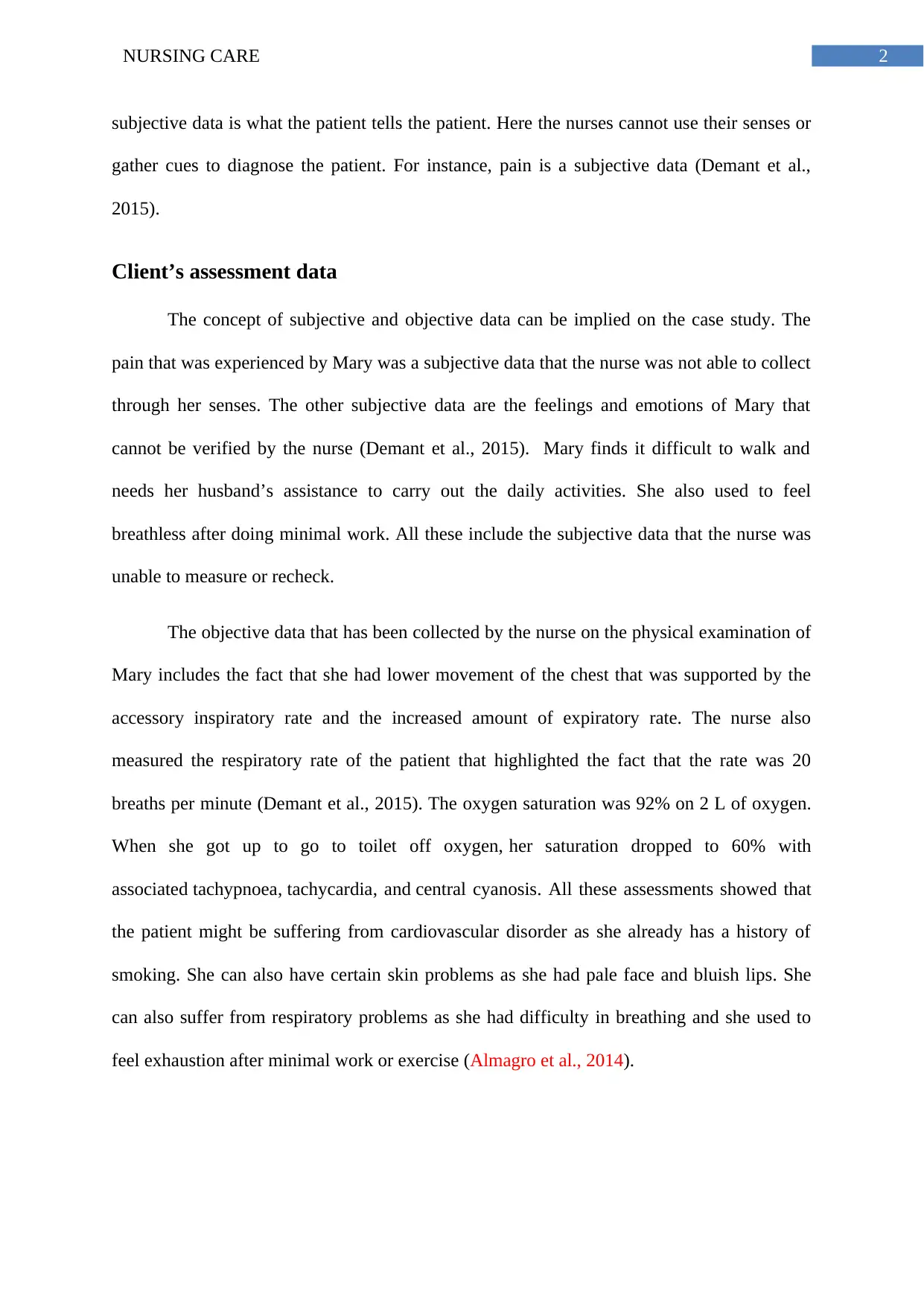
2NURSING CARE
subjective data is what the patient tells the patient. Here the nurses cannot use their senses or
gather cues to diagnose the patient. For instance, pain is a subjective data (Demant et al.,
2015).
Client’s assessment data
The concept of subjective and objective data can be implied on the case study. The
pain that was experienced by Mary was a subjective data that the nurse was not able to collect
through her senses. The other subjective data are the feelings and emotions of Mary that
cannot be verified by the nurse (Demant et al., 2015). Mary finds it difficult to walk and
needs her husband’s assistance to carry out the daily activities. She also used to feel
breathless after doing minimal work. All these include the subjective data that the nurse was
unable to measure or recheck.
The objective data that has been collected by the nurse on the physical examination of
Mary includes the fact that she had lower movement of the chest that was supported by the
accessory inspiratory rate and the increased amount of expiratory rate. The nurse also
measured the respiratory rate of the patient that highlighted the fact that the rate was 20
breaths per minute (Demant et al., 2015). The oxygen saturation was 92% on 2 L of oxygen.
When she got up to go to toilet off oxygen, her saturation dropped to 60% with
associated tachypnoea, tachycardia, and central cyanosis. All these assessments showed that
the patient might be suffering from cardiovascular disorder as she already has a history of
smoking. She can also have certain skin problems as she had pale face and bluish lips. She
can also suffer from respiratory problems as she had difficulty in breathing and she used to
feel exhaustion after minimal work or exercise (Almagro et al., 2014).
subjective data is what the patient tells the patient. Here the nurses cannot use their senses or
gather cues to diagnose the patient. For instance, pain is a subjective data (Demant et al.,
2015).
Client’s assessment data
The concept of subjective and objective data can be implied on the case study. The
pain that was experienced by Mary was a subjective data that the nurse was not able to collect
through her senses. The other subjective data are the feelings and emotions of Mary that
cannot be verified by the nurse (Demant et al., 2015). Mary finds it difficult to walk and
needs her husband’s assistance to carry out the daily activities. She also used to feel
breathless after doing minimal work. All these include the subjective data that the nurse was
unable to measure or recheck.
The objective data that has been collected by the nurse on the physical examination of
Mary includes the fact that she had lower movement of the chest that was supported by the
accessory inspiratory rate and the increased amount of expiratory rate. The nurse also
measured the respiratory rate of the patient that highlighted the fact that the rate was 20
breaths per minute (Demant et al., 2015). The oxygen saturation was 92% on 2 L of oxygen.
When she got up to go to toilet off oxygen, her saturation dropped to 60% with
associated tachypnoea, tachycardia, and central cyanosis. All these assessments showed that
the patient might be suffering from cardiovascular disorder as she already has a history of
smoking. She can also have certain skin problems as she had pale face and bluish lips. She
can also suffer from respiratory problems as she had difficulty in breathing and she used to
feel exhaustion after minimal work or exercise (Almagro et al., 2014).
⊘ This is a preview!⊘
Do you want full access?
Subscribe today to unlock all pages.

Trusted by 1+ million students worldwide

3NURSING CARE
Assessment by nurse
The virtual nurse in order to be sure of the diagnostic pathway performed certain
assessment tests. These assessment tests include the various data that were mentioned by the
nurse and were classified either as subjective or objective (Menezes et al., 2014). The nurse
made efforts to know the details of the patients is that the medical history can be identified
and Mary can be assessed properly. As patients are older, it is important for good health care
to obtain a good record that includes data on social circumstances and behavior in addition to
medical and family history (Watz et al., 2014).
The nurse should examine the severity of the exacerbations in the patient. The main
point of assessing the patient for the exacerbations is that the nurse will be able to know on
how to manage the patient. This means if the exacerbations are severe then the nurse has to
take help from other healthcare staff (Lahousse et al., 2015).
Additional nursing focused assessments
The nurse also performed the respiratory assessment. The nurse performed the upper
and lower respiratory System Physical Assessment. For the nose and throat assessment the
nose is examined and palpated that check the symmetry, lesions and deformation. To search
for the nares for patency, there should be use of a neuro torch that will be the test for
the septal deviation (Almagro et al., 2014). Palpate the sinuses that are frontal and maxillary.
Palpate the trachea, note any midline deviation, and palpate the lymph nodes of the cervical.
Inspect the lips, tongue, palate, uvula, gums and teeth. Inspect for carriages of cuts, bleeding
or dental. Inspect the length and condition of the tonsils (Postma & Rabe, 2015). For the
thorax and the and lungs there should be inspection of the head, it should be remembered
symmetry and chest wall shape, palpation for lumps, masses and tenderness and verify chest
Assessment by nurse
The virtual nurse in order to be sure of the diagnostic pathway performed certain
assessment tests. These assessment tests include the various data that were mentioned by the
nurse and were classified either as subjective or objective (Menezes et al., 2014). The nurse
made efforts to know the details of the patients is that the medical history can be identified
and Mary can be assessed properly. As patients are older, it is important for good health care
to obtain a good record that includes data on social circumstances and behavior in addition to
medical and family history (Watz et al., 2014).
The nurse should examine the severity of the exacerbations in the patient. The main
point of assessing the patient for the exacerbations is that the nurse will be able to know on
how to manage the patient. This means if the exacerbations are severe then the nurse has to
take help from other healthcare staff (Lahousse et al., 2015).
Additional nursing focused assessments
The nurse also performed the respiratory assessment. The nurse performed the upper
and lower respiratory System Physical Assessment. For the nose and throat assessment the
nose is examined and palpated that check the symmetry, lesions and deformation. To search
for the nares for patency, there should be use of a neuro torch that will be the test for
the septal deviation (Almagro et al., 2014). Palpate the sinuses that are frontal and maxillary.
Palpate the trachea, note any midline deviation, and palpate the lymph nodes of the cervical.
Inspect the lips, tongue, palate, uvula, gums and teeth. Inspect for carriages of cuts, bleeding
or dental. Inspect the length and condition of the tonsils (Postma & Rabe, 2015). For the
thorax and the and lungs there should be inspection of the head, it should be remembered
symmetry and chest wall shape, palpation for lumps, masses and tenderness and verify chest
Paraphrase This Document
Need a fresh take? Get an instant paraphrase of this document with our AI Paraphraser

4NURSING CARE
expansion symmetry. The percussion over the rear fields of the lung the practice the
percussion technique and the nurse should try to equate right to left (Lahousse et al., 2015).
The next assessment that has to be done for the patient involves the checking up for
the fall risk management. This should be done by the nurse as she was suffering from reduced
mobility. Risk assessment of fall and the injuries that are related to falling is designed to
identify the history, and injury risk factors. The method aids in creating and tracking
a prevention plan, and monitoring patient involvement, referrals, reassessments, and
preparing for discharge (Phelan et al., 2015).
After this, the nurse should perform the nutrition status of the patient should be done.
This will help in the analysis of the situation of the patient and the condition that is being
faced by the patient (Taffet, Donohue & Altman, 2014). A nutrition evaluation is a
complete assessment of both the objective and the subjective data relating to the intake of
food and nutrients, lifestyle, and medical history of an individual. After gathering and
arranging the data on a patient, the practitioner may assess and analyze the person's
nutritional status (Schols et al., 2014).
The final assessment will comprise of the pressure risk management. This will help in
monitoring the development of the sores and ulcers due to excessive pressure on the legs.
This is because the patient is not able to walk properly. Pressure ulcers occur mostly in
people with minimal mobility and nerve damage, such as the older, people with spinal injury,
and long-term patients in hospitals (Moore & Cowman, 2014). The assessment should be
based on the time for which the patient has been hospitalized. In case of Mary who was
suspected to suffer from COPD, the initial assessment should be done after the hospitalization
of the patient and then it should be done after every 48 hours whenever there is change in the
condition of the patient.
expansion symmetry. The percussion over the rear fields of the lung the practice the
percussion technique and the nurse should try to equate right to left (Lahousse et al., 2015).
The next assessment that has to be done for the patient involves the checking up for
the fall risk management. This should be done by the nurse as she was suffering from reduced
mobility. Risk assessment of fall and the injuries that are related to falling is designed to
identify the history, and injury risk factors. The method aids in creating and tracking
a prevention plan, and monitoring patient involvement, referrals, reassessments, and
preparing for discharge (Phelan et al., 2015).
After this, the nurse should perform the nutrition status of the patient should be done.
This will help in the analysis of the situation of the patient and the condition that is being
faced by the patient (Taffet, Donohue & Altman, 2014). A nutrition evaluation is a
complete assessment of both the objective and the subjective data relating to the intake of
food and nutrients, lifestyle, and medical history of an individual. After gathering and
arranging the data on a patient, the practitioner may assess and analyze the person's
nutritional status (Schols et al., 2014).
The final assessment will comprise of the pressure risk management. This will help in
monitoring the development of the sores and ulcers due to excessive pressure on the legs.
This is because the patient is not able to walk properly. Pressure ulcers occur mostly in
people with minimal mobility and nerve damage, such as the older, people with spinal injury,
and long-term patients in hospitals (Moore & Cowman, 2014). The assessment should be
based on the time for which the patient has been hospitalized. In case of Mary who was
suspected to suffer from COPD, the initial assessment should be done after the hospitalization
of the patient and then it should be done after every 48 hours whenever there is change in the
condition of the patient.
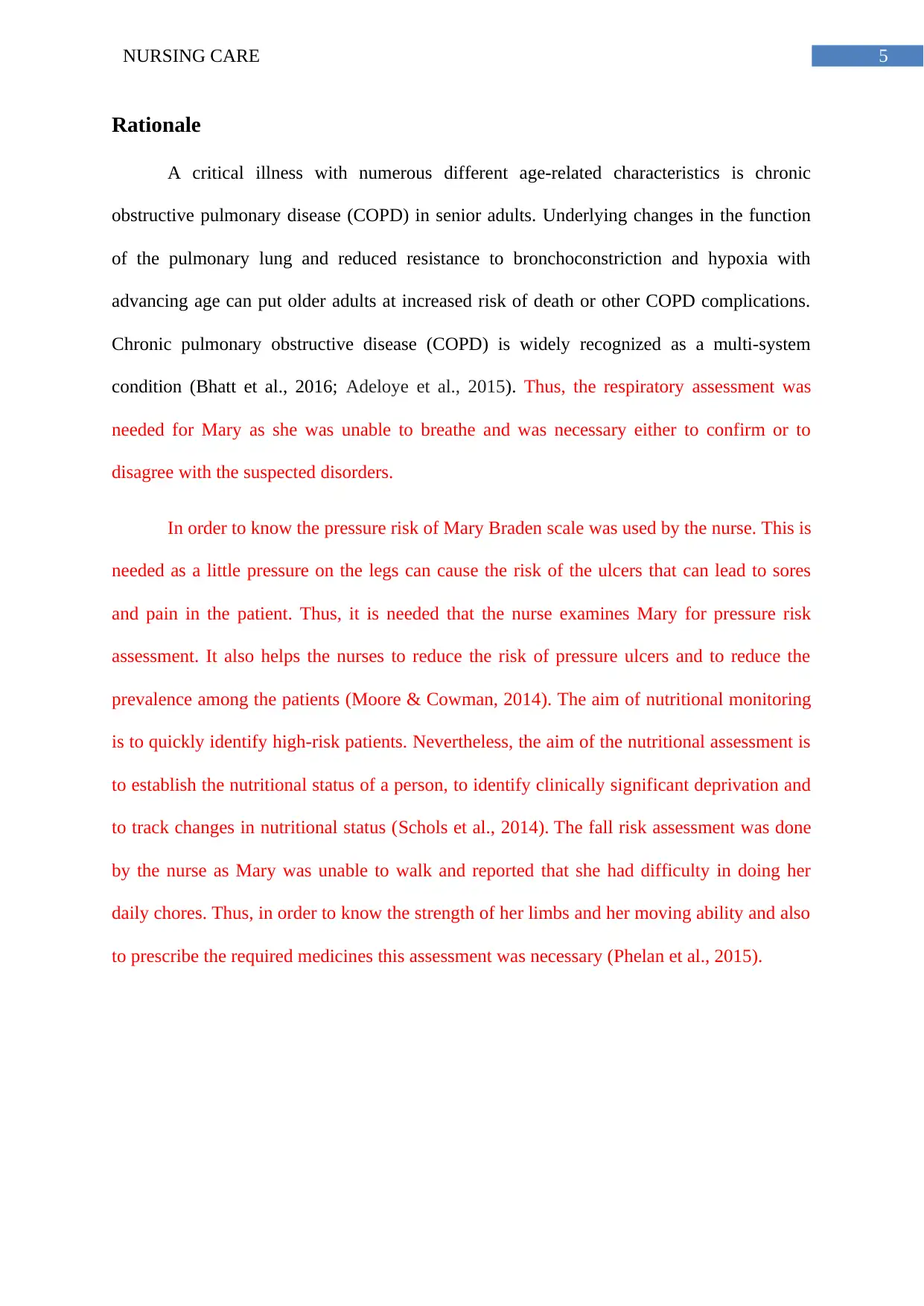
5NURSING CARE
Rationale
A critical illness with numerous different age-related characteristics is chronic
obstructive pulmonary disease (COPD) in senior adults. Underlying changes in the function
of the pulmonary lung and reduced resistance to bronchoconstriction and hypoxia with
advancing age can put older adults at increased risk of death or other COPD complications.
Chronic pulmonary obstructive disease (COPD) is widely recognized as a multi-system
condition (Bhatt et al., 2016; Adeloye et al., 2015). Thus, the respiratory assessment was
needed for Mary as she was unable to breathe and was necessary either to confirm or to
disagree with the suspected disorders.
In order to know the pressure risk of Mary Braden scale was used by the nurse. This is
needed as a little pressure on the legs can cause the risk of the ulcers that can lead to sores
and pain in the patient. Thus, it is needed that the nurse examines Mary for pressure risk
assessment. It also helps the nurses to reduce the risk of pressure ulcers and to reduce the
prevalence among the patients (Moore & Cowman, 2014). The aim of nutritional monitoring
is to quickly identify high-risk patients. Nevertheless, the aim of the nutritional assessment is
to establish the nutritional status of a person, to identify clinically significant deprivation and
to track changes in nutritional status (Schols et al., 2014). The fall risk assessment was done
by the nurse as Mary was unable to walk and reported that she had difficulty in doing her
daily chores. Thus, in order to know the strength of her limbs and her moving ability and also
to prescribe the required medicines this assessment was necessary (Phelan et al., 2015).
Rationale
A critical illness with numerous different age-related characteristics is chronic
obstructive pulmonary disease (COPD) in senior adults. Underlying changes in the function
of the pulmonary lung and reduced resistance to bronchoconstriction and hypoxia with
advancing age can put older adults at increased risk of death or other COPD complications.
Chronic pulmonary obstructive disease (COPD) is widely recognized as a multi-system
condition (Bhatt et al., 2016; Adeloye et al., 2015). Thus, the respiratory assessment was
needed for Mary as she was unable to breathe and was necessary either to confirm or to
disagree with the suspected disorders.
In order to know the pressure risk of Mary Braden scale was used by the nurse. This is
needed as a little pressure on the legs can cause the risk of the ulcers that can lead to sores
and pain in the patient. Thus, it is needed that the nurse examines Mary for pressure risk
assessment. It also helps the nurses to reduce the risk of pressure ulcers and to reduce the
prevalence among the patients (Moore & Cowman, 2014). The aim of nutritional monitoring
is to quickly identify high-risk patients. Nevertheless, the aim of the nutritional assessment is
to establish the nutritional status of a person, to identify clinically significant deprivation and
to track changes in nutritional status (Schols et al., 2014). The fall risk assessment was done
by the nurse as Mary was unable to walk and reported that she had difficulty in doing her
daily chores. Thus, in order to know the strength of her limbs and her moving ability and also
to prescribe the required medicines this assessment was necessary (Phelan et al., 2015).
⊘ This is a preview!⊘
Do you want full access?
Subscribe today to unlock all pages.

Trusted by 1+ million students worldwide
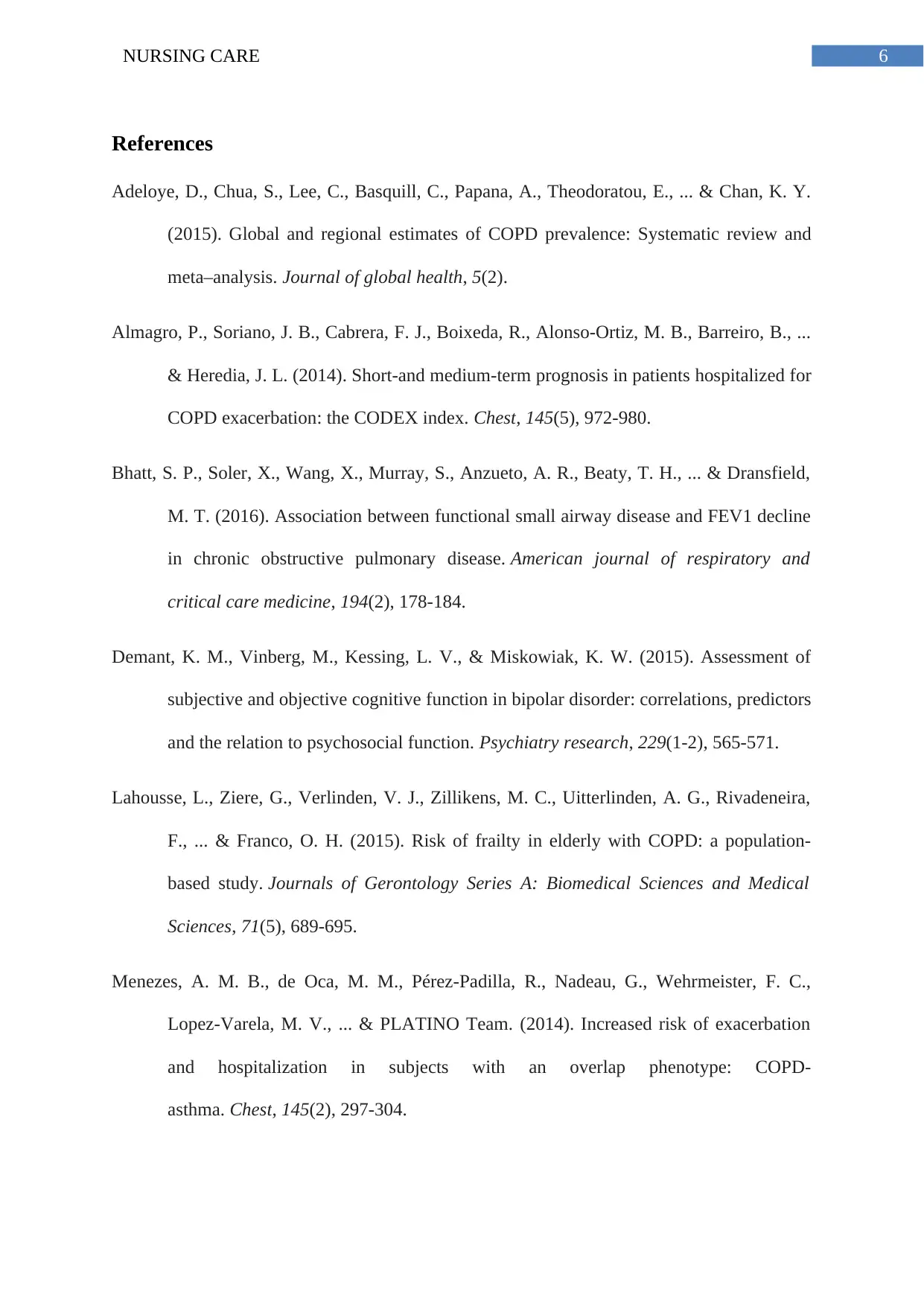
6NURSING CARE
References
Adeloye, D., Chua, S., Lee, C., Basquill, C., Papana, A., Theodoratou, E., ... & Chan, K. Y.
(2015). Global and regional estimates of COPD prevalence: Systematic review and
meta–analysis. Journal of global health, 5(2).
Almagro, P., Soriano, J. B., Cabrera, F. J., Boixeda, R., Alonso-Ortiz, M. B., Barreiro, B., ...
& Heredia, J. L. (2014). Short-and medium-term prognosis in patients hospitalized for
COPD exacerbation: the CODEX index. Chest, 145(5), 972-980.
Bhatt, S. P., Soler, X., Wang, X., Murray, S., Anzueto, A. R., Beaty, T. H., ... & Dransfield,
M. T. (2016). Association between functional small airway disease and FEV1 decline
in chronic obstructive pulmonary disease. American journal of respiratory and
critical care medicine, 194(2), 178-184.
Demant, K. M., Vinberg, M., Kessing, L. V., & Miskowiak, K. W. (2015). Assessment of
subjective and objective cognitive function in bipolar disorder: correlations, predictors
and the relation to psychosocial function. Psychiatry research, 229(1-2), 565-571.
Lahousse, L., Ziere, G., Verlinden, V. J., Zillikens, M. C., Uitterlinden, A. G., Rivadeneira,
F., ... & Franco, O. H. (2015). Risk of frailty in elderly with COPD: a population-
based study. Journals of Gerontology Series A: Biomedical Sciences and Medical
Sciences, 71(5), 689-695.
Menezes, A. M. B., de Oca, M. M., Pérez-Padilla, R., Nadeau, G., Wehrmeister, F. C.,
Lopez-Varela, M. V., ... & PLATINO Team. (2014). Increased risk of exacerbation
and hospitalization in subjects with an overlap phenotype: COPD-
asthma. Chest, 145(2), 297-304.
References
Adeloye, D., Chua, S., Lee, C., Basquill, C., Papana, A., Theodoratou, E., ... & Chan, K. Y.
(2015). Global and regional estimates of COPD prevalence: Systematic review and
meta–analysis. Journal of global health, 5(2).
Almagro, P., Soriano, J. B., Cabrera, F. J., Boixeda, R., Alonso-Ortiz, M. B., Barreiro, B., ...
& Heredia, J. L. (2014). Short-and medium-term prognosis in patients hospitalized for
COPD exacerbation: the CODEX index. Chest, 145(5), 972-980.
Bhatt, S. P., Soler, X., Wang, X., Murray, S., Anzueto, A. R., Beaty, T. H., ... & Dransfield,
M. T. (2016). Association between functional small airway disease and FEV1 decline
in chronic obstructive pulmonary disease. American journal of respiratory and
critical care medicine, 194(2), 178-184.
Demant, K. M., Vinberg, M., Kessing, L. V., & Miskowiak, K. W. (2015). Assessment of
subjective and objective cognitive function in bipolar disorder: correlations, predictors
and the relation to psychosocial function. Psychiatry research, 229(1-2), 565-571.
Lahousse, L., Ziere, G., Verlinden, V. J., Zillikens, M. C., Uitterlinden, A. G., Rivadeneira,
F., ... & Franco, O. H. (2015). Risk of frailty in elderly with COPD: a population-
based study. Journals of Gerontology Series A: Biomedical Sciences and Medical
Sciences, 71(5), 689-695.
Menezes, A. M. B., de Oca, M. M., Pérez-Padilla, R., Nadeau, G., Wehrmeister, F. C.,
Lopez-Varela, M. V., ... & PLATINO Team. (2014). Increased risk of exacerbation
and hospitalization in subjects with an overlap phenotype: COPD-
asthma. Chest, 145(2), 297-304.
Paraphrase This Document
Need a fresh take? Get an instant paraphrase of this document with our AI Paraphraser

7NURSING CARE
Moore, Z. E., & Cowman, S. (2014). Risk assessment tools for the prevention of pressure
ulcers. Cochrane Database of Systematic Reviews, (2).
Phelan, E. A., Mahoney, J. E., Voit, J. C., & Stevens, J. A. (2015). Assessment and
management of fall risk in primary care settings. The Medical clinics of North
America, 99(2), 281–293. doi:10.1016/j.mcna.2014.11.004
Postma, D. S., & Rabe, K. F. (2015). The asthma–COPD overlap syndrome. New England
Journal of Medicine, 373(13), 1241-1249.
Schols, A. M., Ferreira, I. M., Franssen, F. M., Gosker, H. R., Janssens, W., Muscaritoli,
M., ... & Tkacova, R. (2014). Nutritional assessment and therapy in COPD: a
European Respiratory Society statement.
Suzuki, M., Makita, H., Ito, Y. M., Nagai, K., Konno, S., & Nishimura, M. (2014). Clinical
features and determinants of COPD exacerbation in the Hokkaido COPD cohort
study. European Respiratory Journal, 43(5), 1289-1297.
Taffet, G. E., Donohue, J. F., & Altman, P. R. (2014). Considerations for managing chronic
obstructive pulmonary disease in the elderly. Clinical interventions in aging, 9, 23.
Watz, H., Pitta, F., Rochester, C. L., Garcia-Aymerich, J., ZuWallack, R., Troosters, T., ... &
Vogiatzis, I. (2014). An official European Respiratory Society statement on physical
activity in COPD.
Moore, Z. E., & Cowman, S. (2014). Risk assessment tools for the prevention of pressure
ulcers. Cochrane Database of Systematic Reviews, (2).
Phelan, E. A., Mahoney, J. E., Voit, J. C., & Stevens, J. A. (2015). Assessment and
management of fall risk in primary care settings. The Medical clinics of North
America, 99(2), 281–293. doi:10.1016/j.mcna.2014.11.004
Postma, D. S., & Rabe, K. F. (2015). The asthma–COPD overlap syndrome. New England
Journal of Medicine, 373(13), 1241-1249.
Schols, A. M., Ferreira, I. M., Franssen, F. M., Gosker, H. R., Janssens, W., Muscaritoli,
M., ... & Tkacova, R. (2014). Nutritional assessment and therapy in COPD: a
European Respiratory Society statement.
Suzuki, M., Makita, H., Ito, Y. M., Nagai, K., Konno, S., & Nishimura, M. (2014). Clinical
features and determinants of COPD exacerbation in the Hokkaido COPD cohort
study. European Respiratory Journal, 43(5), 1289-1297.
Taffet, G. E., Donohue, J. F., & Altman, P. R. (2014). Considerations for managing chronic
obstructive pulmonary disease in the elderly. Clinical interventions in aging, 9, 23.
Watz, H., Pitta, F., Rochester, C. L., Garcia-Aymerich, J., ZuWallack, R., Troosters, T., ... &
Vogiatzis, I. (2014). An official European Respiratory Society statement on physical
activity in COPD.
1 out of 8
Related Documents
Your All-in-One AI-Powered Toolkit for Academic Success.
+13062052269
info@desklib.com
Available 24*7 on WhatsApp / Email
![[object Object]](/_next/static/media/star-bottom.7253800d.svg)
Unlock your academic potential
Copyright © 2020–2025 A2Z Services. All Rights Reserved. Developed and managed by ZUCOL.





